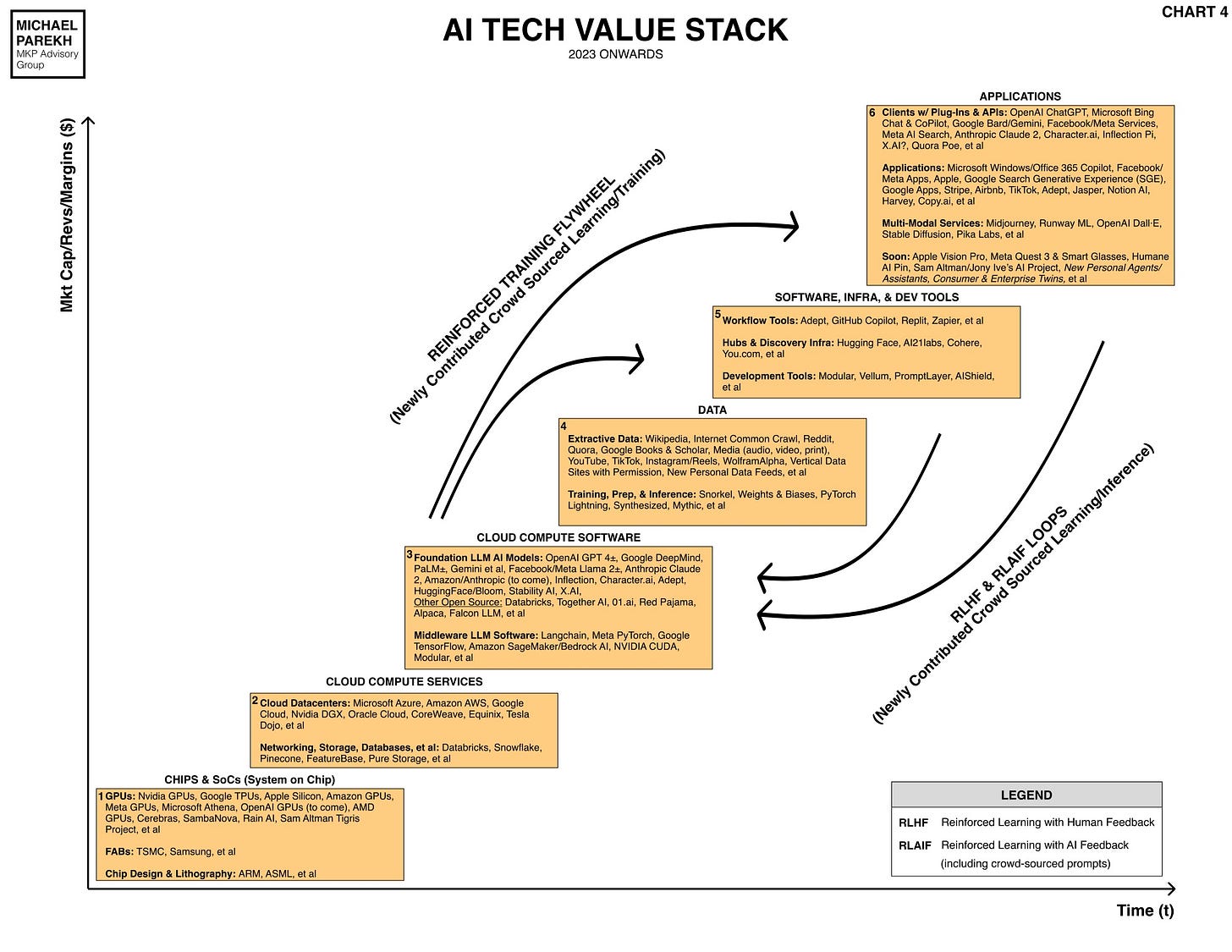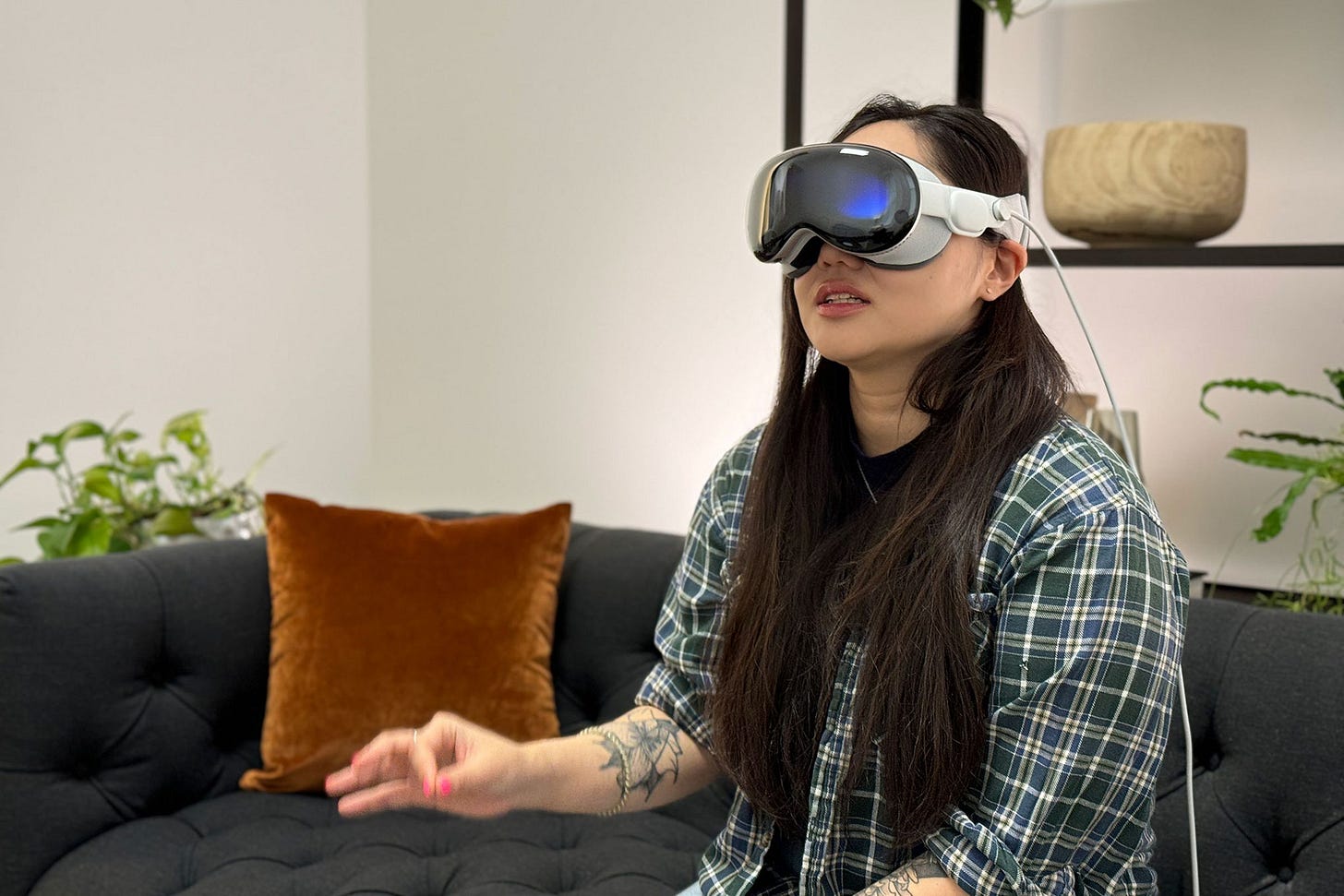AI: Understanding Apple's Vision Pro
...both the new 'medium' and the long-term 'message'
Let’s continue discussing Apple after my ‘Calling the Shot’ post yesterday on Apple and its AI long game. Especially after its new Vision Pro launch. It’s much discussed as CEO Tim Cook’s ‘legacy’ for Apple going forward, particularly after the iconic Steve Jobs.
I’ve talked about the Vision Pro before on Apple doing it ‘the Apple Way’. And counter-intuitively, how they’re not as expensive in historical technology terms, even at $3,499 and up.
Today, I’d like to focus on the long-term implications and possibilities of Apple’s Vision Pro ‘Spatial Computing’ platform, as they like everyone to phrase it. And parse the short and long-term implications for the tech and AI industry and the AI Tech Wave at large. Especially in the all important Box no. 6 below, which is the long game for all the ‘Magnificent 7’ and others.
Like most of Apple’s big technology initiatives, Vision Pro shares some characteristics that are of note. It’s important for AI since its a delivery vehicle of AI and machine learning (ML) in all multimodal forms. Just as PCs, smartphones and more have been to date.
Key point to remember at the outset is the following.
Apple is almost never the first, but generally the best:
If one looks back at Apple’s ‘platform’ record over the decades, the company is generally never the first in a hot new tech area. But when it does make its move, it’s typically a committed, focused, and multi-year bet on making it a vertically integrated ‘Best’. With an almost religious ‘attention to detail’, fusing both the hardware and software elements. With the North Star of the eventual user experience.
Let’s look at the broad strokes through tech history. Yes and Apple typically relabels the tech to whatever it wants. (This time it’s ‘Spatial Computing’ instead of ‘VR, AR or MR’, to the chagrin of many).
Let’s look at this ‘late’ but eventually ‘best’ trend through Apple’s history, especially driven by Steve Jobs:
GUI (Graphical User Interface) pioneering Macs in the 1980s, bringing the world from the ‘Command Line’ of Microsoft’s MS-DOS to their eventual success with Windows 95 and beyond,
to its Internet ‘built-in’ iMacs in 1997 when Steve Jobs ‘came back’ to Apple,
to the iPod that revamped the Music industry from albums to buying music tracks individually, changing the habits of billions in how they consumed music,
to of course the mobile phone with the iPhone in 2007 after Blackberry and many others had already ‘taken the lead’, redefining the ‘Smart Phone’, and establishing the ‘App Store’ and App Economy that now sees over a trillion in business activity per year,
to the Airpods in the ‘Wearables’ space, overtaking prior wired and wireless efforts,
to the Apple Watch, which continued the ‘Wearables’ progression from others, painstakingly iterating over many years,
to now the Vision Pro in headsets that have seen billions in expenditures by everyone from Meta/Facebook with Oculus/Quest headsets to Microsoft, Sony, and so many others.
In each of the above, the notable item from both a financial and secular technology perspective has been how ‘Medium’ changed, thus fundamentally changing the ‘Message’. Of course as the venerable ‘communication theorist’ Marshall McLuhan would say (‘Medium is the Message’).
In other words, Apple’s iteration of the above technologies fundamentally influenced how everyone of their competitors/peers implemented those technologies going forward.
And went on to change the way the content, applictions, services, and ultimately the Experiences distributed via those new ‘Medium’ delivering mechanisms. Fundamentally changing them irrevocably going forward. This would of course be across many industries that were previously not as impacted by Moore’s Law driven technologies.
Then there’s the most important part of these Apple iterations of the new technology driven ‘Medium’: the fundamental change in Behaviors of billions in how they interacted with ‘Message’ of those technologies.
How it changed the habits of billions in how we message in ‘Blue Bubble’ iMessages, consumer music after iPods, interact with digital information with miniature computers on our wrists and in our ears, and of course consume almost everything via our ‘smartphones’.
The Vision Pro is the beginning of that shift as some have said we mount ‘Computers' to our Face’, as the WSJ’s Joanna Stern has noted. Very complex and initially expensive computers, that are for now uncomfortably heavy as tech observers like MKBHD have continually noted. But most are entranced with the ease of interacting with the Vision Pro world’s Vision OS with one’s fingers.
We are uncertain as the ‘Killer Apps’ of this new device as opined on by the Verge’s David Pierce and others. It could be so many possibilities. One possibility is consuming Sports in a visceral experience of being at the stadium in the best seats. Note how my former GS colleague Jim Cramer describes that experience with the Vision Pro:
“I am an intense viewer of sports and I can’t believe how I can be court-side with this device or the front rows of a big football or baseball game. I saw a soccer match on the Vision Pro and I ducked when a ball came right at me. Courtside playoff tickets to the New York Knicks cost $30,000. I would have had better seats with the Vision Pro, if Apple can work out that deal with NBA commissioner Adam Silver. But the best thing would be NFL football. I can envision a world where I can put four or five RedZone screens up at once and see all my favorite players on the Skidaddies (my Mad Money fantasy league team) score touchdowns.”
Some market watchers have theorized that this mainstream application for billions may have influenced Apple’s key Vision Pro content and services partner Disney, and its CEO Bob Iger, to hang on to ESPN.
Or watching movies on massive virtual screens with extraordinary ‘spatial’ sounds, or doing our work on computers at our desk virtually, with ‘pinchy pinch’ of our fingers.
Movies and TV viewing is important despite the current hesitations and negotiations of key video/music partners like Netflix, Google YouTube, Spotify and others to not launch Vision Pro optimized versions of its services for now, as discussed by Stratechery’s Ben Thompson in notable detail.
Coming back to Vision Pro’s underlying technologies, also notable is Apple’s pioneering developments, that track the movements of our eyes and magically enable clicks and swipes with our gestures and voice. The general feedback on the device, now tried by hundreds of reviewers under Appe’s supervision, remains net positive.
Whether we do these interactions ‘Leaning in’ while we’re working on virtual screens, or ‘Leaning back’ watching TV/movies, as highlighted by my friend Om Malik. And of course viewing our personal photos and videos in both dimensions by ourselves or with friends and family.
Yes, the devices are not as light, less expensive, and far less comfortable in their current incarnations with today’s technologies. But the technologies are fast-moving hockey pucks (a la Scott McNealy), and the changes we know will come fast and furious. Especially with Apple’s keen attention to detail to the hardware and software, and of course the experience in every moment.
The devices are already in demand by early adopters, and the initial volumes are relatively minuscule, as highlighted by noted Apple analyst Ming-Chi Kuo, particularly for the scale of the longer term opportunity:
“The immediate sold-out when pre-orders opened confirms earlier predictions. However, the inability to sustain a steady increase in pre-order demand is a major concern and also confirms earlier concerns about whether the intensity of demand can be sustained. Click here and here for details of my previous predictions.
“Analysis”:
“Based on pre-order inventory and shipping time, I estimated that Apple sold 160,000 to 180,000 Vision Pro units during the first pre-order weekend.”
“As predicted, the Vision Pro sold out immediately after the pre-order opened, with shipping times for all models extending to 5–7 weeks within hours.”
“The instant sold-out and extended shipping times seem positive at first, but a key concern emerged: shipping times remained unchanged 48 hours after pre-orders opened. It indicates that demand may quickly taper off after the core fans and heavy users place their orders.”
“Popular iPhone models also sell out immediately upon pre-order, and shipping times typically increase to several weeks within hours. However, unlike Vision Pro, iPhone models usually continue to see a steady increase in shipping times 24 to 48 hours after pre-orders open, indicating that demand continues to grow even after the initial sold-out.”
“Media reports have suggested that supply chain partners such as assembler Luxshare will work overtime during the Lunar New Year to meet demand, meaning better than expected demand for Vision Pro. However, the reality is that because there is still room for improvement in Vision Pro production efficiency, Luxshare has been working full-time overtime since the start of mass production to offset the impact of production efficiency on shipments.”
“Achieving a shipment volume of 500,000 units for Vision Pro this year should not be challenging. However, because demand tapers off quickly after the initial sold-out, it’s critical to closely monitor demand in other markets and application updates to assess changes in demand.”
“Apple has a massive user base of over 1.2 billion active users. As long as about 0.007% of users are willing to buy after pre-ordering, Vision Pro can sell out after opening for pre-order. So, right now, Vision Pro is still a very niche product.”
I cite his points above to highlight the immediate financial details of the Vision Pro that many will focus on. And of course argue the relative possible failure, or the success of Apple’s Vision Pro, depending on the point they’re out to make.
But I’d encourage us all to consider the broader implications of Apple’s moves with the Vision Pro. The real long term game afoot. That is what will matter in terms of Marshall McLuhan’s Medium and its eventual Message here going forward. Stay tuned.
(NOTE: The discussions here are for information purposes only, and not meant as investment advice at any time. Thanks for joining us here)









